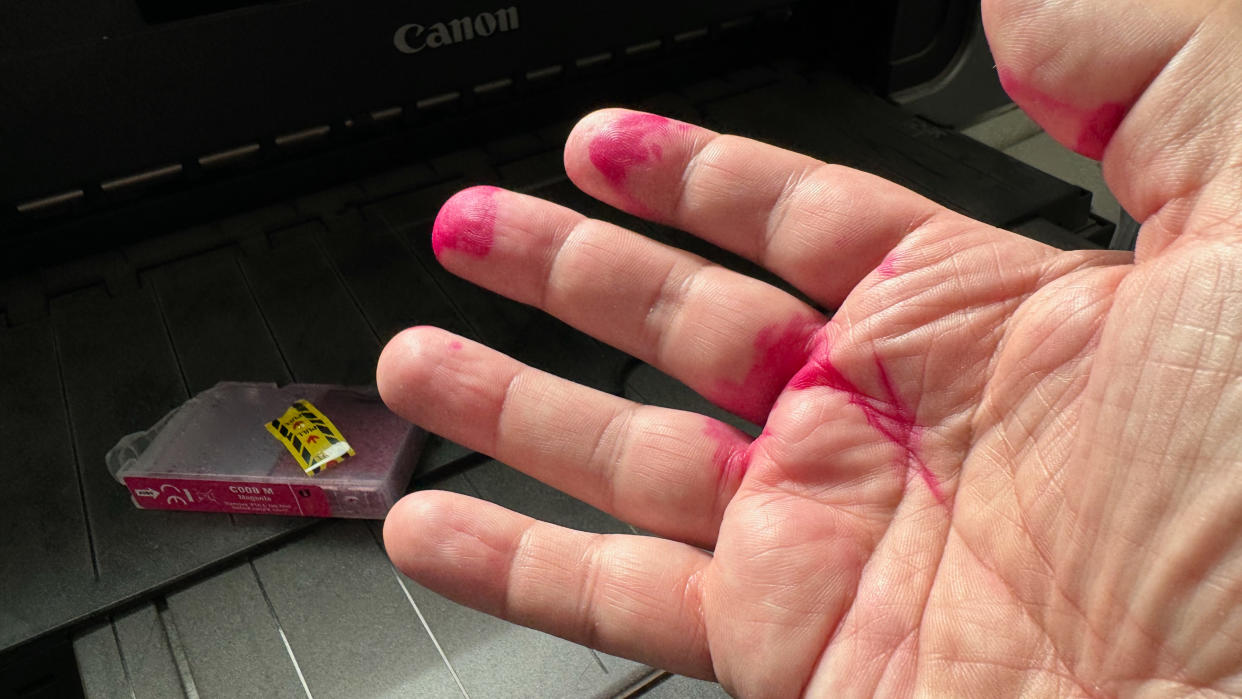I used to print in color with a black-and-white Canon printer, and it wasn't THIS messy!

What is it about printer ink? Somehow it contrives to spread all over a standard sheet of paper, getting into the gaps, and when you print a barcode for postage it doesn't always scan properly unless you use very expensive paper. And when the ink cartridge explodes onto your hand, it manages to give you a pretty effective temporary tattoo.
Now it could've looked a little bit more "murdery", I admit, but it's not great. My Canon Pixma Pro 9000, released in 2007, has 8 colors including a red and a green – so if I had red ink all over my hands, it would definitely look a lot more like blood. But today it's a brand new magenta that is dripped out.
The question is, do I actually have a right to be upset about this? You see, I'm not actually using Canon-branded ink cartridges.
For many years of this more-than-a-decade-old printer's life, I doggedly stuck to the idea that I had to use the manufacturer's own-brand inks. But about five years ago I found it very hard to get hold of Canon cartridges, at least without taking out a bank loan, so switched to site I found offering equivalent. This seems a more environmentally rational approach than simply junking the printer, which more or less still works (although admittedly it could do with a clean).
I also continue to be surprised that, several versions, later macOS still supports it. I've owned a fair few computers in that time – I think the Mac I had when I bought the printer was a G4, so I've gone Intel (the first intel Mac was announced in 2006) and back. For me at least, buying a printer is less exciting than a computer. I just want it to work.
Now admittedly I've had to replace the inks more than I'd like, and while the photo quality is great if I've got all-new inks and I've got high-quality photo paper, perhaps I haven't used it as much as I should've done. Most of the time the printer sits and waits, the inks gently evaporating… until, like today, I have a minor printing task and I end up having to swap one of the tanks.
Actually, I had to swap three. The green and the black went just fine. Then the magenta… well, you can see the picture of my hand above. The design of the tanks requires you to take off a clip at the bottom, which seals the point thing that comes out and protects the chip, and then remove a small cover.
This mess reminds me of a time when I used to have an Acorn Archimedes computer, and a Canon BJ-10ex bubble jet printer. With a special piece of software, my dad and I could make this black-and-white printer print in color by flushing some old cartridges with water and then injecting cyan, magenta and yellow ink. You then had to print a page four times through the printer, but the result was color – and, in the mid-Nineties at least, that's pretty impressive. On our budget, anyway.
As you can imagine, though, flushing out used ink cartridges and then injecting new ink wasn't the cleanest of processes. The thing is, here and now, a quarter of a century later, using dedicated cartridges, I don't understand why I'm getting into more (or at least the same) amount of mess.
With cartridges at over $20 apiece for a set of 8 for genuine ones (if you can find them at all) or about the same for a set of "fakes" and it being a lot easier to reliably order them, is a bit of ink on my hand worth the risk? Canon's cartridges might have had better manufacturing standards, but the design principles were the same so ink drips weren't beyond the bounds of possibility after all…
Check out guide to the best photo printers and best large format printers.

